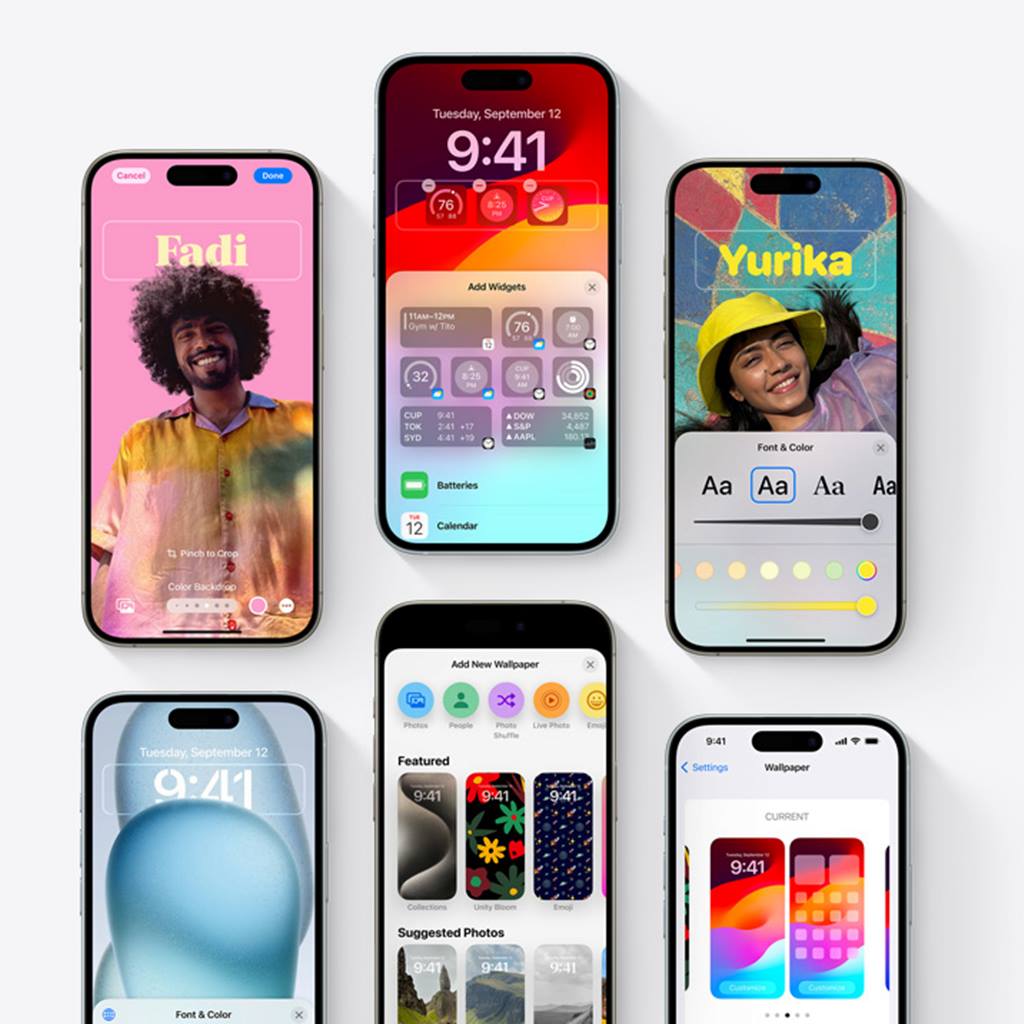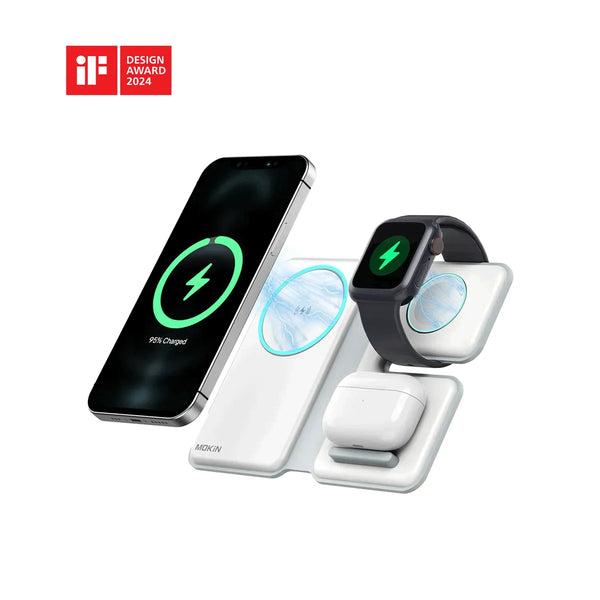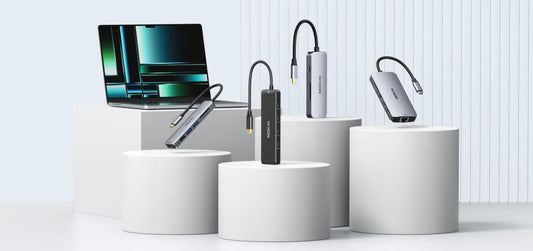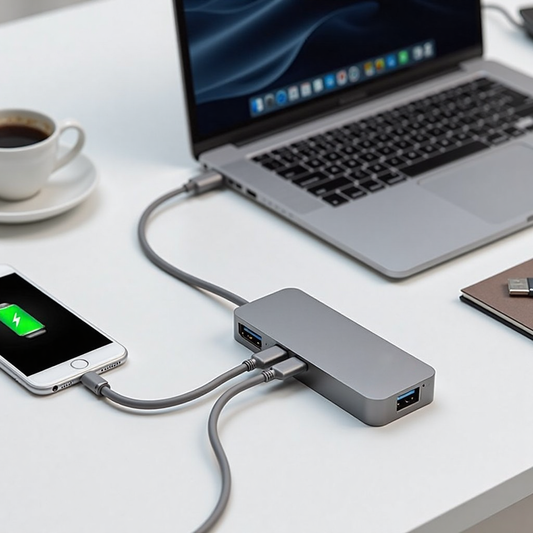Understanding iPhone Charging Ports: From Lightning to USB-C
Contents
Since the launch of the first-generation iPhone in 2007, Apple has introduced a total of 42 iPhone models over the past 16 years.
As technology has advanced and smartphone battery capacities have increased, the charging interface has become a concern for users on the go. Most iPhones have utilized the Lightning interface, requiring users to locate a Lightning cable in any charging scenario. Currently, the newly released iPhone 15 series features a USB Type-C interface, yet the majority of Apple users continue to rely on the Lightning interface. To help users clearly understand the interfaces of various iPhone models, MOKiN will summarize the products from the first-generation iPhone to the iPhone 15 series, highlighting the models with different interfaces.
I. USB Type-C:
——————————
The following summarizes iPhones with a USB Type-C interface. According to the data, only the iPhone 15 series supports the USB Type-C interface, including the iPhone 15, iPhone 15 Plus, iPhone 15 Pro, and iPhone 15 Pro Max. This transition marks the end of Apple's decade-long use of the Lightning interface. The adoption of the USB Type-C interface has eliminated the need for users to carry multiple cables, reduced electronic waste from cables, and enhanced the utility of USB Type-C cables.
iPhone mobile phone third-generation charging interface (USB Type-C)
| Device Name | Charging Port | Standard Charging Cable | Whether to support PD fast charging | Standard Charger | Release Date | Battery Capacity (mAh) |
| iPhone 15 Pro Max | USB Type-C | USB-C to USB-C | Support | None | 2023/9/13 | 4422 |
| iPhone 15 Pro | USB Type-C | USB-C to USB-C | Support | None | 2023/9/13 | 3274 |
| iPhone 15 Plus | USB Type-C | USB-C to USB-C | Support | None | 2023/9/13 | 4383 |
| iPhone 15 | USB Type-C | USB-C to USB-C | Support | None | 2023/9/13 | 3349 |
Compared to previous generations, the entire iPhone 15 series features a more universal USB-C charging interface, offering portability for charging and improved data transmission efficiency. This interface allows users to charge their iPhone, Mac, iPad, and the new AirPods Pro (second generation) with a single cable. Additionally, the USB-C port supports reverse charging, enabling users to charge their AirPods or Apple Watch directly via their iPhone, simplifying the charging process and enhancing the user experience. The data transmission efficiency of the USB-C interface significantly improves transfer speeds, with the Pro version supporting USB 3.0 and achieving speeds of up to 10 Gbps per second.
MOKiN 3 IN 1 Magnetic Wireless Charging Station For iPhone
2. Lightning:
——————————
On September 12, 2012, Apple introduced the new Lightning Dock interface at the Yerba Buena Convention Center in San Francisco, USA. Known as the "Lightning" interface, it is Apple's longest-serving and most widely used charging interface. This new interface standard also marked the end of Apple's 9-year use of the 30-pin Dock interface.
iPhone mobile phone second-generation charging interface (Lightning)
| Device Name | Charging Port | Standard Charging Cable | Whether to support PD fast charging | Standard Charger | Release Date | Battery Capacity (mAh) |
| iPhone 14 Pro Max | Lightning | USB-C to Lightning | Support | None | 2022/9/8 | 4323 |
| iPhone 14 Pro | Lightning | USB-C to Lightning | Support | None | 2022/9/8 | 3200 |
| iPhone 14 Plus | Lightning | USB-C to Lightning | Support | None | 2022/9/8 | 4325 |
| iPhone 14 | Lightning | USB-C to Lightning | Support | None | 2022/9/8 | 3279 |
| iPhone SE 3 | Lightning | USB-A to Lightning | Support | None | 2022/3/8 | 2018 |
| iPhone 13 Pro Max | Lightning | USB-C to Lightning | Support | None | 2021/9/15 | 4352 |
| iPhone 13 Pro | Lightning | USB-C to Lightning | Support | None | 2021/9/15 | 3095 |
| iPhone 13 | Lightning | USB-C to Lightning | Support | None | 2021/9/15 | 3227 |
| iPhone 13 mini | Lightning | USB-C to Lightning | Support | None | 2021/9/15 | 2406 |
| iPhone 12 Pro Max | Lightning | USB-C to Lightning | Support | None | 2020/10/14 | 3687 |
| iPhone 12 Pro | Lightning | USB-C to Lightning | Support | None | 2020/10/14 | 2815 |
| iPhone 12 | Lightning | USB-C to Lightning | Support | None | 2020/10/14 | 2851 |
| iPhone 12 mini | Lightning | USB-C to Lightning | Support | None | 2020/10/14 | 2227 |
| iPhone SE 2 | Lightning | USB-A to Lightning | Support | 5W | 2020/4/15 | 1821 |
| iPhone 11 Pro Max | Lightning | USB-C to Lightning | Support | 18W | 2019/9/11 | 3969 |
| iPhone 11 Pro | Lightning | USB-C to Lightning | Support | 18W | 2019/9/11 | 3046 |
| iPhone 11 | Lightning | USB-A to Lightning | Support | 5W | 2019/9/11 | 3110 |
| iPhone XS Max | Lightning | USB-A to Lightning | Support | 5W | 2018/9/13 | 3174 |
| iPhone XS | Lightning | USB-A to Lightning | Support | 5W | 2018/9/13 | 2658 |
| iPhone XR | Lightning | USB-A to Lightning | Support | 5W | 2018/9/13 | 2942 |
| iPhone X | Lightning | USB-A to Lightning | Support | 5W | 2017/9/13 | 2716 |
| iPhone 8 Plus | Lightning | USB-A to Lightning | Support | 5W | 2017/9/13 | 2691 |
| iPhone 8 | Lightning | USB-A to Lightning | Support | 5W | 2017/9/13 | 1821 |
| iPhone 7 Plus | Lightning | USB-A to Lightning | Yes | 5W | 2016/9/8 | 2900 |
| iPhone 7 | Lightning | USB-A to Lightning | Yes | 5W | 2016/9/8 | 1960 |
| iPhone SE | Lightning | USB-A to Lightning | Yes | 5W | 2016/3/21 | 1624 |
| iPhone 6s Plus | Lightning | USB-A to Lightning | Yes | 5W | 2015/9/10 | 2750 |
| iPhone 6s | Lightning | USB-A to Lightning | Yes | 5W | 2015/9/10 | 1715 |
| iPhone 6 Plus | Lightning | USB-A to Lightning | Yes | 5W | 2014/9/10 | 2915 |
| iPhone 6 | Lightning | USB-A to Lightning | Yes | 5W | 2014/9/10 | 1810 |
| iPhone 5s | Lightning | USB-A to Lightning | Yes | 5W | 2013/9/10 | 1560 |
| iPhone 5C | Lightning | USB-A to Lightning | Yes | 5W | 2013/9/10 | 1510 |
| iPhone 5 | Lightning | USB-A to Lightning | Yes | 5W | 2012/9/13 | 1440 |
The Lightning interface offered several advantages over its predecessor, the 30-pin Dock port. It reduced the volume of the original interface by 80%, providing more design flexibility for the iPhone and making the iPhone 5 the lightest phone in Apple's history. The new interface features 8-pin contacts on both sides, allowing for insertion in any direction without the risk of misalignment. Apple also touted the new interface as being more user-friendly, durable, and expandable. In 2017, it was updated to support the PD fast charging protocol, enabling Apple to join the fast charging revolution.
Initially, the Lightning interface was synonymous with advanced charging technology. However, with the introduction of the USB-C interface, which supports forward and reverse insertion and offers superior performance, the advantages of the Lightning interface have diminished. The Lightning interface, designed with simplicity and ease of use in mind, features only 16 pins, compared to 24 pins on the USB-C interface, limiting the iPhone's data transmission rate to USB2.0. Additionally, the physical limitations of the Lightning interface's pins restrict its current-carrying capacity, preventing it from fully supporting fast charging capabilities despite Apple's efforts to incorporate fast charging technology.
3. 30-pin Dock port:
——————————
The first-generation iPhone, released in 2007, featured a bulky 30-pin Dock interface, which was Apple's inaugural charging solution for its smartphones. This interface, with its numerous pins, remained in use until it was replaced by the Lightning interface, with two pins remaining unused.
| Device Name | Charging Port | Standard Charging Cable | Whether to support PD fast charging | Standard Charger | Release Date | Battery Capacity (mAh) |
| iPhone 4S | 30-pin Dock port | USB-A to 30-pin Dock port | Yes | 5W | 2011/10/5 | 1432 |
| iPhone 4 | 30-pin Dock port | USB-A to 30-pin Dock port | Yes | 5W | 2010/6/8 | 1420 |
| iPhone 3GS | 30-pin Dock port | USB-A to 30-pin Dock port | Yes | 5W | 2009/6/9 | 1219 |
| iPhone 3G | 30-pin Dock port | USB-A to 30-pin Dock port | Yes | 5W | 2008/6/10 | 1150 |
| iPhone | 30-pin Dock port | USB-A to 30-pin Dock port | Yes | 5W | 2007/1/9 | 1400 |
This summary covers the models that utilized the 30-pin Dock interface. This interface was in service on Apple phones for nearly five years. In Apple's early products, the 30-pin Dock interface performed its duties admirably. Despite its large size, it boasted a high pin count and supported the native USB 2 protocol, enabling iPhones to perform multiple functions supported by USB 2 without the need for conversion chips. It could handle connections and signal outputs for multiple protocols and facilitate the output of audio and video analog signals.
Summary:
——————————
The following outlines the evolution of iPhone model interfaces over the generations.
| Device Name | Charging Port | Standard Charging Cable | Whether to support PD fast charging | Standard Charger | Release Date | Battery Capacity (mAh) |
| iPhone 15 Pro Max | USB Type-C | USB-C to USB-C | Support | None | 2023/9/13 | 4422 |
| iPhone 15 Pro | USB Type-C | USB-C to USB-C | Support | None | 2023/9/13 | 3274 |
| iPhone 15 Plus | USB Type-C | USB-C to USB-C | Support | None | 2023/9/13 | 4383 |
| iPhone 15 | USB Type-C | USB-C to USB-C | Support | None | 2023/9/13 | 3349 |
| iPhone 14 Pro Max | Lightning | USB-C to Lightning | Support | None | 2022/9/8 | 4323 |
| iPhone 14 Pro | Lightning | USB-C to Lightning | Support | None | 2022/9/8 | 3200 |
| iPhone 14 Plus | Lightning | USB-C to Lightning | Support | None | 2022/9/8 | 4325 |
| iPhone 14 | Lightning | USB-C to Lightning | Support | None | 2022/9/8 | 3279 |
| iPhone SE 3 | Lightning | USB-A to Lightning | Support | None | 2022/3/9 | 2018 |
| iPhone 13 Pro Max | Lightning | USB-C to Lightning | Support | None | 2021/9/15 | 4352 |
| iPhone 13 Pro | Lightning | USB-C to Lightning | Support | None | 2021/9/15 | 3095 |
| iPhone 13 | Lightning | USB-C to Lightning | Support | None | 2021/9/15 | 3227 |
| iPhone 13 mini | Lightning | USB-C to Lightning | Support | None | 2021/9/15 | 2406 |
| iPhone 12 Pro Max | Lightning | USB-C to Lightning | Support | None | 2020/10/14 | 3687 |
| iPhone 12 Pro | Lightning | USB-C to Lightning | Support | None | 2020/10/14 | 2815 |
| iPhone 12 | Lightning | USB-C to Lightning | Support | None | 2020/10/14 | 2851 |
| iPhone 12 mini | Lightning | USB-C to Lightning | Support | None | 2020/10/14 | 2227 |
| iPhone SE 2 | Lightning | USB-A to Lightning | Support | 5W | 2020/4/15 | 1821 |
| iPhone 11 Pro Max | Lightning | USB-C to Lightning | Support | 18W | 2019/9/11 | 3969 |
| iPhone 11 Pro | Lightning | USB-C to Lightning | Support | 18W | 2019/9/11 | 3046 |
| iPhone 11 | Lightning | USB-A to Lightning | Support | 5W | 2019/9/11 | 3110 |
| iPhone XS Max | Lightning | USB-A to Lightning | Support | 5W | 2018/9/13 | 3174 |
| iPhone XS | Lightning | USB-A to Lightning | Support | 5W | 2018/9/13 | 2658 |
| iPhone XR | Lightning | USB-A to Lightning | Support | 5W | 2018/9/13 | 2942 |
| iPhone X | Lightning | USB-A to Lightning | Support | 5W | 2017/9/13 | 2716 |
| iPhone 8 Plus | Lightning | USB-A to Lightning | Support | 5W | 2017/9/13 | 2691 |
| iPhone 8 | Lightning | USB-A to Lightning | Support | 5W | 2017/9/13 | 1821 |
| iPhone 7 Plus | Lightning | USB-A to Lightning | Yes | 5W | 2016/9/8 | 2900 |
| iPhone 7 | Lightning | USB-A to Lightning | Yes | 5W | 2016/9/8 | 1960 |
| iPhone SE | Lightning | USB-A to Lightning | Yes | 5W | 2016/3/21 | 1624 |
| iPhone 6s Plus | Lightning | USB-A to Lightning | Yes | 5W | 2015/9/10 | 2750 |
| iPhone 6s | Lightning | USB-A to Lightning | Yes | 5W | 2015/9/10 | 1715 |
| iPhone 6 Plus | Lightning | USB-A to Lightning | Yes | 5W | 2014/9/10 | 2915 |
| iPhone 6 | Lightning | USB-A to Lightning | Yes | 5W | 2014/9/10 | 1810 |
| iPhone 5s | Lightning | USB-A to Lightning | Yes | 5W | 2013/9/10 | 1560 |
| iPhone 5C | Lightning | USB-A to Lightning | Yes | 5W | 2013/9/10 | 1510 |
| iPhone 5 | Lightning | USB-A to Lightning | Yes | 5W | 2012/9/13 | 1440 |
| iPhone 4S | 30-pin Dock port | USB-A to 30-pin Dock port | Yes | 5W | 2011/10/5 | 1432 |
| iPhone 4 | 30-pin Dock port | USB-A to 30-pin Dock port | Yes | 5W | 2010/6/8 | 1420 |
| iPhone 3GS | 30-pin Dock port | USB-A to 30-pin Dock port | Yes | 5W | 2009/6/9 | 1219 |
| iPhone 3G | 30-pin Dock port | USB-A to 30-pin Dock port | Yes | 5W | 2008/6/10 | 1150 |
| iPhone | 30-pin Dock port | USB-A to 30-pin Dock port | Yes | 5W | 2007/1/9 | 1400 |
Apple's initial 30-pin Dock interface and some second-generation Lightning interfaces did not support fast charging. In 2017, Apple began integrating PD fast charging with the iPhone 8, a USB-A to Lightning charging cable. In 2019, the iPhone 11 Pro started shipping with a USB-C to Lightning charging cable and an 18W fast charging charger. Subsequently, for environmental reasons, Apple ceased including a charging head, providing only a charging cable. As of now, the new iPhone 15 series has transitioned to a USB Type-C charging interface, updating the charging cable accordingly.
Among the 42 iPhones released from the iPhone 1 to the iPhone 15 series, as many as 33 models were equipped with Lightning interfaces, which outnumber the combined total of 30-pin Dock interfaces and USB Type-C interfaces by more than three times, generating substantial profits for Apple.
In terms of the proportion of iPhone charging interfaces, currently, USB Type-C interfaces represent only 9% of the total. The lifespan of an Apple interface is notably long; the Lightning interface, for instance, has been in use for eleven years. With the ongoing release of new Apple phones, the market share of USB Type-C interfaces is expected to continue rising and is projected to surpass the Lightning interface, becoming the predominant interface model on Apple phones.

MOKiN 13-IN-1 USB-C Laptop Charging Station with 2.26-inch LCD Smart Display










